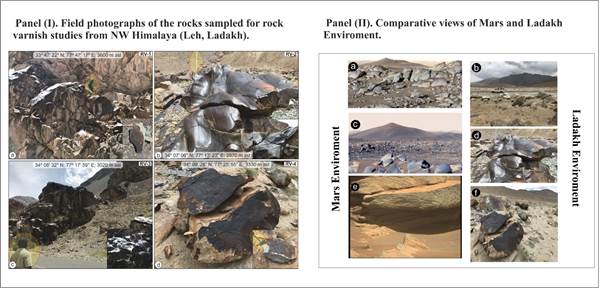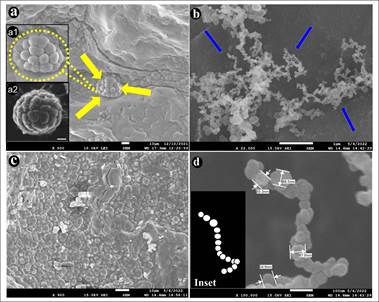Magnetofossils– fossil remains of magnetic particles produced by magnetotactic bacteria have been spotted in rock varnish layers in Ladakh. The study suggesting biotic processes in the formation of rock varnish indicates how life can exist in extreme environments, providing valuable insights for astrobiology as well as for planning future space missions targeting to identify habitable environments in space.
Ladakh, known as the “cold desert of India,” experiences extreme climatic conditions such as high UV radiation, significant temperature variations, and limited water availability, making it a suitable terrestrial analogue for Martian studies.
Researchers from Birbal Sahni Institute of Palaeosciences, Lucknow (BSIP), an autonomous institute of Department of science and Technology (DST) were inspired by the similarity between the rock varnish observed in Ladakh and that seen on Mars, particularly during the Perseverance rover operations.
They collected samples of rock varnish from the Ladakh region, chosen and employed XPS to analyse the surface chemistry of the rock varnish. The analysis conducted by the lead author Dr. Amritpal Singh Chaddha and Dr. Anupam Sharma at BSIP with its Sophisticated Analytical Instrumentation Facility (SAIF) established by DST, helped identify the nanochains of magnetofossils.
Additionally, higher concentrations of oxidized manganese (Mn4+) and carboxylic acid functionality on the varnish surface were identified, indicating organic signatures.
The study published in Planetary and Space Science showed that rock varnish from Ladakh, a potential Martian analogue site, contains enriched concentrations of magnetic minerals likely derived from biotic sources.
The findings highlighted the potential of rock varnish as an archive of ancient environmental records and as a geomaterial for astrobiological studies.
By identifying biotic signatures in rock varnish, scientists can better target potential biosignatures on Mars and other planetary bodies, aiding the search for extraterrestrial life. This information is crucial for planning future space missions by ISRO and other space agencies, including Mars exploration, where identifying habitable environments is a primary goal.

Fig.1 Field photographs of the rocks sampled for rock varnish studies from NW Himalaya (Leh, Ladakh). The photographs from (a) to (d) panel I represent the rocks designated as spots RV-1 to RV-4 respectively. Panel II shows striking similarities bewteen rock coatings on Mars and Ladakh Enviroment.

Fig.2 (a) FE-SEM image of the varnish layer showing the presence of magnetotactic multicellular aggregate (MMA) type entity embedded in the varnish layer marked by yellow arrows ; inset a1 shows magnified morphology of MMA type entity, showcasing clear morphological features; inset a2 is a SEM image of magnetotactic multicellular aggregate (MMA) (b) FE-SEM image displaying clusters of chain-like magnetosome morphology in the varnish layer; (d) High resolution magnified FE-SEM image from panel c indicated by left most blue arrow illustrating the chain-like morphology of magnetosomes present in the varnish layer, with an inset depicting a graphic description of magnetosomes’ shape.
 Matribhumi Samachar English
Matribhumi Samachar English


